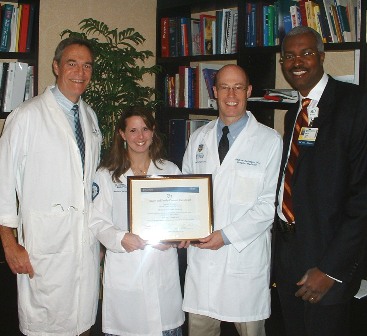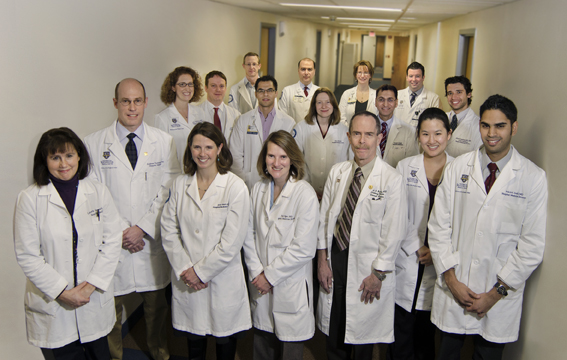Scores Prove: Hospitalists Paving Way for Better Patient Experience
 “Journeying through a health system is bewildering for patients and families,” admits hospitalist Andrew Rudmann, M.D. “We sometimes forget that, because we work here.”
“Journeying through a health system is bewildering for patients and families,” admits hospitalist Andrew Rudmann, M.D. “We sometimes forget that, because we work here.”
But hospitalization can overwhelm patients fast—especially in an academic medical environment, where each day might bring a merry-go-round of new nurses, nursing and medical students, residents, fellows, and other providers.
“That’s why solid communication is absolutely critical,” Rudmann (pictured second from right, next to PFCC medical director Jean Joseph, M.D., far right) says. “For hospitalists, that means cementing ourselves in our patients’ minds as their first point of contact. We want to make it clear that we’re willing to take responsibility for their experience.”
As chief of URMC’s Division of Hospital Medicine, Rudmann and fellow hospitalists are looking to make the hospital more intelligible, and a little smaller. Their techniques—handing business cards to patients, calling home to “check up” after they’ve left— are certainly creative.
More importantly, they’re working.
A Steady Climb: Making Strides
In recent years, Rudmann says efforts made by the division (pictured below) have been paying off.
Take their scores on the HCAHPS survey, 27 questions mailed randomly to patients after a hospital stay, asking them to rate various aspects of their care experience. In particular, part of the questionnaire zeros in on “good doctor-to-patient communication” in the form of three questions, focusing on how well doctors:
-
Listen to patients’ concerns
-
Explain things in clear and understandable language
-
Treat patients with courtesy and respect.
Since the 2009-10 ranking period—when surveys reported 70 percent of respondents thought that providers “ALWAYS” communicated well—scores have climbed steadily. By the 2012-13 assessment, that favorable response had nudged up to 75 percent.
 While that might seem like small movement over a few years’ time, it’s significant because it’s steady; it’s also impressive when stacked up against other hospitalists in the University Healthcare Consortium (an alliance of 118 academic medical centers and 298 of their affiliated hospitals—effectually, URMC’s academic medical center peers). Ranked against the UHC group’s scores, URMC hospitalists have moved from between the 30th and 40th percentile three years back, to the 51st in the most recent marking period.
While that might seem like small movement over a few years’ time, it’s significant because it’s steady; it’s also impressive when stacked up against other hospitalists in the University Healthcare Consortium (an alliance of 118 academic medical centers and 298 of their affiliated hospitals—effectually, URMC’s academic medical center peers). Ranked against the UHC group’s scores, URMC hospitalists have moved from between the 30th and 40th percentile three years back, to the 51st in the most recent marking period.
“You have to remember that this is a moving target,” says Jackie Beckerman, director of URMC’s patient- and family-centered care initiative, which helps track such “experience” scores. “It means they’re improving against themselves, but more importantly, they’re doing so at a brisk-enough rate to start outpacing their peers.”
Rudmann agrees. “It’s so encouraging knowing that our hard work is actually paying off. We all come into this field to help people. When they tell us what we’re doing is actually working, it’s the best feeling.”
The List: How Hospitalists are Moving the Needle
While it’s hard to pinpoint precisely what’s buoying the division’s leap in HCAHPS communication scores, one thing is clear: The group’s willingness to work outside the box is impressive.
Below, we’ve chronicled some of their recent tactics:
-
Having docs hand patients their business cards. “We know health care is a team sport, that a lot of people come together to manage a patient’s recovery,” Rudmann explains. “But someone needs to take ownership for the patient’s satisfaction, so we offer to serve as that point of contact. We try to establish this, right from the start, handing each of our admitted patients a business card with our name, photo, and contact information. If the weekend brings a change, we make sure that covering physician does the same thing.”
-
Developing a brochure to explain their roles. What’s a hospitalist anyway? Turns out, many patients don’t know! A brochure explains, in plain language, that hospitalists are physicians dedicated to the care of hospitalized patients. That means they collaborate with surgical and medical specialists during a patient’s stay—and with outpatient primary care physicians and other providers to create safe, smooth transitions after discharge.
-
Making post-discharge phone calls. Within three days of a patient’s discharge, division representatives call patients, asking about their recovery, and if they have any new or unexpected concerns. “If they ask to speak with a physician, one is text-paged to ensure a speedy call-back,” Rudmann adds.
-
Embracing ongoing education. Communication modules (developed by in-house talent, like physician Tim Quill, M.D., who directs the Center for Ethics, Humanities and Palliative Care) focus on sharpening communication skills. Topics range from clearly communicating care goals to deftly and compassionately delivering hard news.
-
Keeping “communication” on the business agenda. Carving out time to talk about progress at monthly division meetings helps fan energy around the new initiatives.
-
Tying performance to financial incentives. Gradually, the division is migrating from its traditional productivity pay incentives to quality incentives—a shift indicative of larger trends ushered in by health care reform. Obviously, efficiency and hard work are still vital—but balancing these with a fresh concern for a patient’s first-class experience is becoming increasingly important.
-
Investing in champions. “We’ve hired Courtney Webb to spend part of her time concentrating on quality improvement,” Rudmann says. “She rounds with us, observing our interactions and making recommendations for focused improvement. She develops templates for best practices, and then assesses us against them. It’s not meant to be punitive; it’s in the interest of helping us understand our opportunities for improvement.” Hospital Medicine also has appointed Kellin King, M.D., as the division’s Patient- and Family-Centered Care (PFCC) director; she’s charged with participating in URMC-wide planning and helping the group maintain momentum around its PFCC improvement efforts.
In sum, Rudmann says the success circles back to one big idea: “The secret is probably our attitude: we’re able to admit that we can always do better. We want to be excellent, and that means always improving.”
Global Administrator |
9/13/2013
You may also like